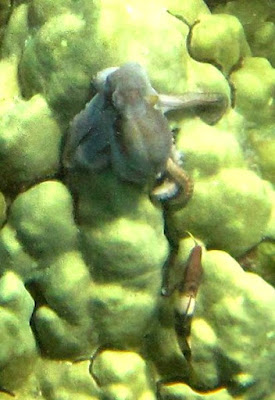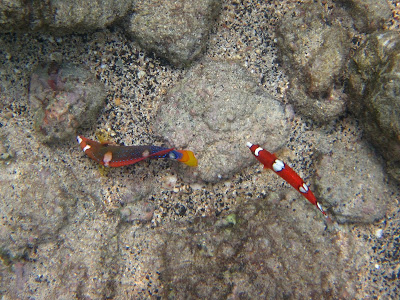 |
| Hai on the landing ramp, kawaihae Harbor and Kohala Mountain |
As we waited for Peter and Marla, what should I see in my rear view mirror, but that distinctive red jeep convertible with a surfboard lashed to the top, the chariot of Hai On. Sure enough, Hai and Lottie emerged and started chatting with the head groundskeeper, Range, who was keeping a watch over the lady with the lawn mower from the tailgate of his truck. In a few minutes, we were joined by the Kroppjes and the six of us were headed across the lot and down to the harbor. As we made the stroll I commended Peter,soto voce, for inviting Hai, critter finder extraordinaire.
The tide was high, making it easy to sit on the landing platform, put on mask and fins and drop into
 |
| The banded coral shrimp, at home on the landing ramp. |
Soon the six of us were snorkeling around the first platform. When everyone is a competent swimmer and on the same page, six is not too many. In other circumstances, this number could mean complete confusion.
Hai had seen a small black frogfish on this platform and was searching for it when Peter made the first sighting of the day. This was a fairly large nudibranch which Hai had seen previously and had sent pictures to Peter. Only moments earlier, I had looked right at it, perched on the end of a branch of cauliflower coral, and thought that it was only the coral tip under stress. Having a search image for the beast may have given Peter an edge. Or maybe he is just damn good at spotting wildlife.
As you know, I give myself some credit for getting fish watching accepted as a sport, similar to bird watching. I don't think anyone used the term in print before I did, At that same time Jack Randall, the dean of saltwater ichthyology, thought that I was full of beans for suggesting it. I say
 |
| Dendrodoris krusensternii, The Carnation Nudibranch |
The problem is this: There are infinitely more invertebrates in our waters than there are species of reef fish...so many that common names just don't work. A trained birdwatcher can pick up John Hoover's Ultimate Guide, learn the 200 fish of the Hawaiian reefs in a few days and he is set. Cory Pittman and Pauline Fiene maintain a website, Seaslugs of Hawaii. They list over 450 species...of nudibranchs! So many that I tired of counting them, much less look at the pictures. John Hoover, in his critter book, shows a handful of these and lists common names. But lets face it, common names just don't work. And no mere hobbyist could approach invertebrate watching in the same way that one becomes a birdwatcher.
Hai spends so much time looking at the nudibranchs, mostly in Kawaihae harbor, that he must be developing quite a list. He is so smart that I think he can refer to his list from memory. I fear that he isn't writing it down, although he is now in contact with Cory Pittman (he of Seaslugs of Hawaii) so maybe there is a written list. Let's hope so! And as he goes along, Hai gives common names to some of the nudibranchs that he sees (and John Hoover hasn't named.). This one is, Dendrodoris krusensternii. While almost an impossible mouthful, this is how one invertebrate zoologist identifies it to his colleagues.
 |
| A beautiful feather duster worm, Kawaihae Harbor July 2019 |
Hai has dubbed it the Carnation Nudibranch, for its floral appearance. Works for me.
Pittman and Fiene note the colorful tubercles and draw our attention to those bright blue dots, which apparently mimic the blue on a highly toxic sea hare, which is sort of like a nudibranch. In addition to capturing those blue spots, I hope you notice that I got a photo in which you can see the antenna-like rhinophores and, at the aft end, some pretty fancy external gills (which give the nudibranchs their name).
Despite looking for a very long time, Hai did not find the small black frogfish, which he said was an inch long and the same shade of black as the numerous black cave sponges. Not only that, after Peter found that spectacular Carnation nudibranch, we did not see another nudibranch of any kind. We did see some nice Hawaiian dascyllus and some fine feather duster worms. The latter are almost plant-like, being anchored in one spot by their calciferous tube. In one instance I was taking a series of pictures, moving ever closer when Presto!, the fancy flower disappeared in an instant into its tube. Obviously, these worms are animals, no matter how plant-like they may appear.
 |
| We photographed this handsome duster an instant before he disappeard. |
pointed out an endangered specimen of rice coral. And Sandra found a spectacular red cushion starfish. Later, over lunch, Hai told us that there are imminent plans to destroy that part of the reef and put in a large recreation boat launch and pier. We wish him luck in his effort to prevent the reef destruction,or, alternatively, to get the government to designate another protected beach and reef just to the south.
🐙 🐙 🐙 🐙 🐙 🐙 🐙 🐙 🐙 🐙 🐙 🐙
With Peter's encouragement I have taken a more studied look at the octopus that Andrew found and directed us to at Kahalu'u. As you will recall, this octopus had unusual coloration and it was
 | |||||
| The crescent octopus, O. hawaiensis. Kahalu'u July 2019 |
 |
| Sandra's bright red cushion starfish! |
 |
| A second look at the Carnation Nudibranch, including the gills. |






















